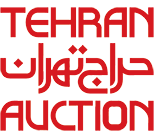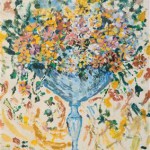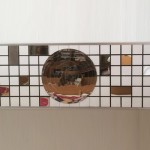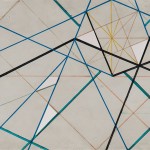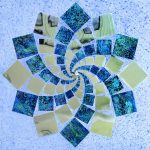Monir Shahroudy Farmanfarmaian is an important unique artist among neo-traditionalist artists of the 1960s. No doubt, she has the keenest interest in geometric forms among Iranian contemporary artists, producing works for more than half a century that change between geometric forms of traditional arts and abstract modernist approaches.
Her art is founded on two major pillars at first sight: decorative designs and mirrors. It is obvious that she has borrowed these two from Iranian traditional arts, relying heavily on mirror work. A closer look, however, reveals that the essence of her art is neither decorations nor mirrors, but geometry. The works of Monir Farmanfarmaian attest to the fact that she is profoundly fascinated by geometry and its unique order and philosophy. Mirror for her is neither a fresh material in art nor a new identity laden with conceptual values; it is merely a tangible experimented bedrock in which she can materialize a geometric system. She could perhaps be able to work with any material other than mirror, but one could not really imagine her divorce from geometric structures. When describing her works, Farmanfarmaian tends to refer to complex geometric forms rather than the formal or conceptual quality of the mirror, “Geometry – square, triangle, and circle – took me back to my homeland, to my experience of living in such a beautiful land as a child. Everything assumed a new meaning – cube, cylinder, and prism.”[1] With this idea in mind, Monir borrowed the mirror from a backdrop of tradition and traditional spaces to combine it with mathematical logic and metaphoric wisdom and create numerous works in a juncture of two contemporaneous approaches, Pop Art and Conceptual Art. Many of her works strive to display solutions to geometric problems or the joy of solving a riddle, e. g. a geometric solution to turn a quadrilateral to a decagon or the division of an octagon into several triangles. Aesthetic joy seems to have intermixed with the joy of solving problems. It is obvious that her solutions are absolutely innovative and different from solutions that are common in Iranian Islamic architecture. All geometric forms and compositions in her works follow a strict symmetric arrangement to imply the order and wisdom behind the entire universe.
Inasmuch as mirror work connects this Iranian avant-garde artist to her past, it gives her art a contemporary touch. Small geometric components in her work cause diffraction in the mirror, yielding a distorted image of the outside world. The spectator who is placed at the center of this world looks at his distorted image. A major part of the conceptual aspect of the work involves reflection of the outside world and the spectator in the mirror, giving her work a sense of being interactive. The mirror, as a distinctive material of Post-modern art, carries metaphysical allusions that have their roots in Persian literature and metaphors, thus it is synonymous to concepts such as light, chastity, fortune, transparency, and integrity. The reflective aspect of mirrors is also significant as it shows an honest image of reality. The Iranian poet, Nezami Ganjavi, says,
When a mirror reveals your imperfection
Change yourself, do not shatter the mirror
The achievements of an entire life of artistic endeavor indicates that Monir Farmanfarmaian was neither interested in academic thinking nor seeking to adhere to avant-garde art. In her exhilarating endeavors, Farmanfarmaian was neither concerned about her work being labeled as decorative nor had an intellectual mission with political and social idealism in mind. At the same time, she never adhered to a specific style in art or attempted to publish a manifesto. Nevertheless, she has definitely inspired many artists of the next generation because of her artistic achievements. Her art is as much based on Modernism as it can be identified with Post-modern movements, including Conceptual Art, Pop Art, and Minimalism. In the history of Iranian modern art, Monir Farmanfarmaian is an eminent artist who tangibly upholds and admires the legacy of Iranian and Islamic art and architecture in her work. She herself has become part of this legacy, securing a high status as a female artist.
The participation of works of Monir Farmanfarmaian in major museums of New York, including the Metropolitan Museum of Art and the Guggenheim Museum, in recent years has been a distinct privilege that has come to few Iranian artists. This international acclaim brought recognition to Farmanfarmaian as a major modern artist in Iran at an old age.
A similar work (100 x 140 cm) by the artist was sold for $377,000 at the Christie’s Dubai Auction in 2016.
[1] Monir Shahroudy Farmanfarmaian, Selected Works, Tehran, Nazar Publishing, 2008, p. 4
